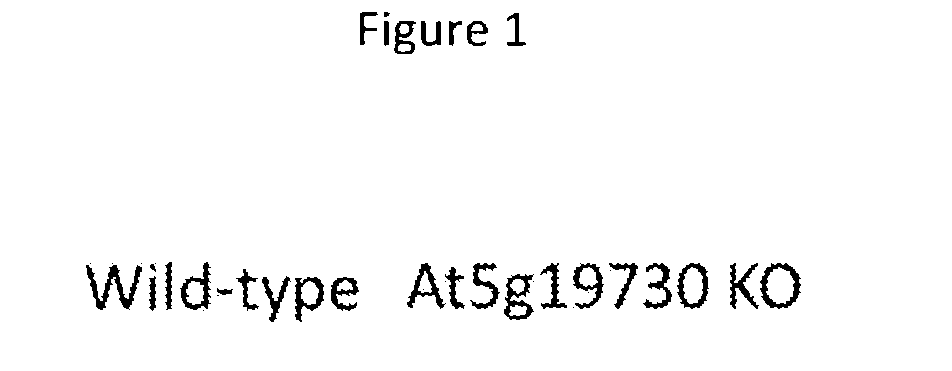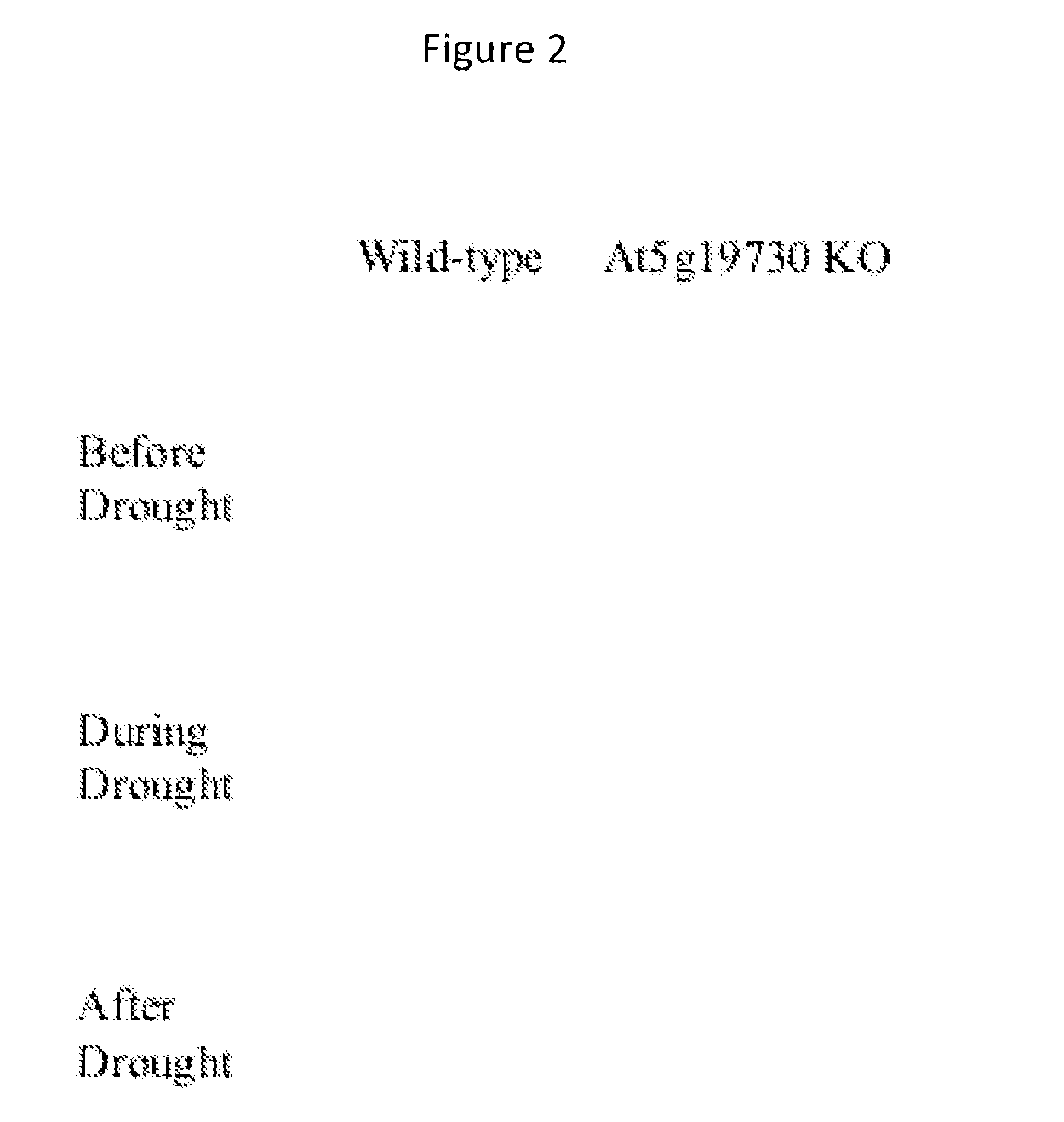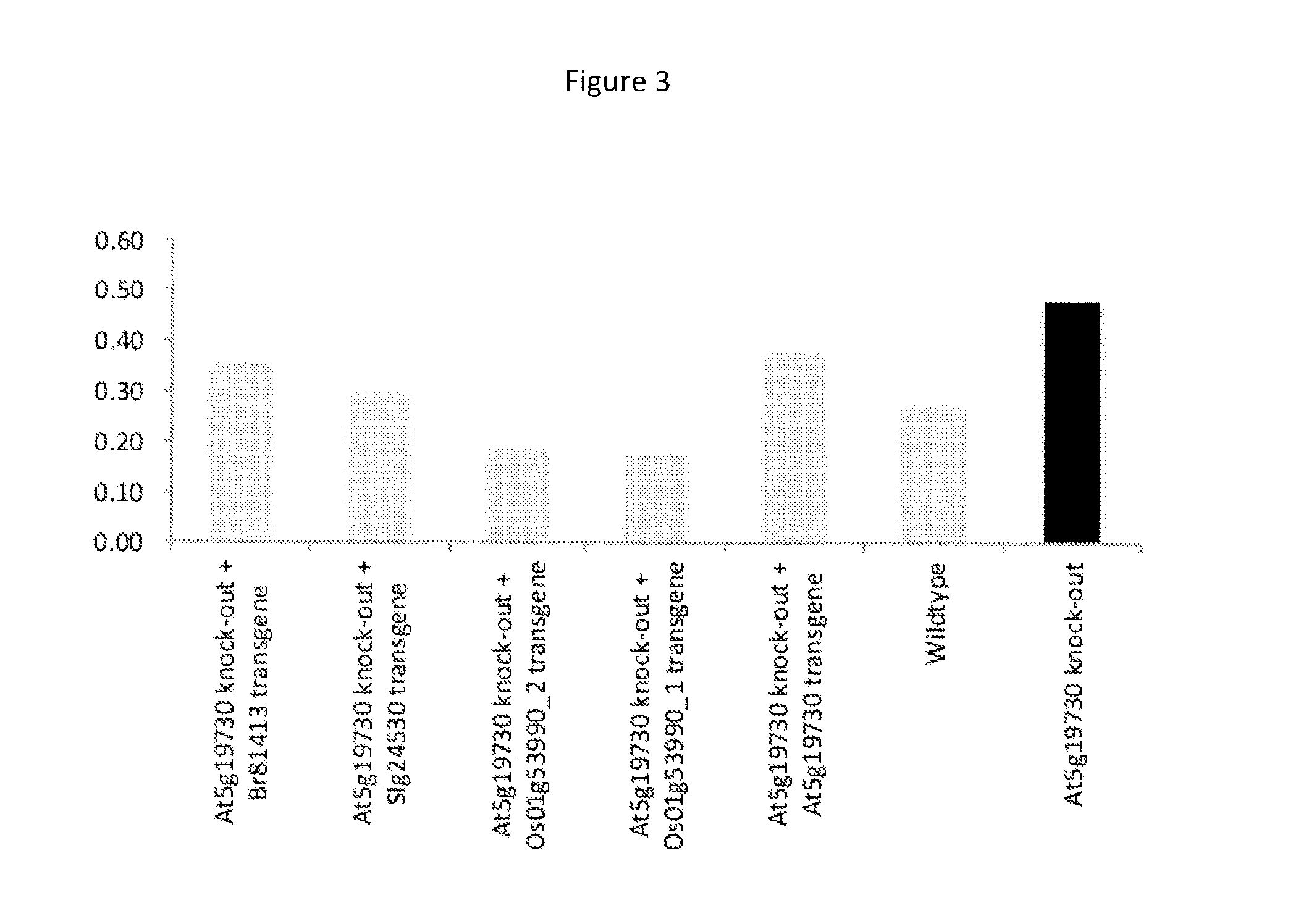Drought resistance in plants: pectinesterase
a technology of drought resistance and plant, applied in the field can solve the problems of plant fitness cost, plant loss worldwide, and significant fitness cost in comparison with plants, and achieve the effect of increasing the drought resistance of plants and impaired drought resistan
- Summary
- Abstract
- Description
- Claims
- Application Information
AI Technical Summary
Benefits of technology
Problems solved by technology
Method used
Image
Examples
example 1
Drought Test
[0109]Arabidopsis thaliana (At) seeds transformed with Agrobacterium tumefaciens vector pROK2, leading to the absence of functional pectinesterase protein (NASC ID: N664100, AGI code At5g19730 and SALK—1365560; hereafter referred to as mutant seeds or mutant plants) were obtained from the Nottingham Arabidopsis Stock Centre (NASC; School of Biosciences, University of Nottingham, Sutton Bonington Campus, Loughborough, LE12 5RD United Kingdom). As control At Col-0 (Columbia, N60000); hereafter referred to as control seed or plant) were used.
[0110]A soil mixture comprising one part of sand and vermiculite and two parts of compost was used (sand:vermiculite:compost=1:1:2). This mixture increases the water percolation hence facilitates uniform water uptake by each pot and better water drainage. Before sowing, the seeds were kept at 4° C. for 3 days under dark and humid conditions for stratification.
[0111]Both mutant and control seeds were sown in a rectangular t...
example 2
Drought Test
[0114]The same mutant and control plants as in Example 1 were grown in similar tray set-up as described above in the pre-screening test. Plants were stressed by withholding water from 15 DAG until the control reached its PWP. During this period every alternate day pots were shuffled within the trays to reduce the position effects and allow uniform evaporation. On day 15 DOD, control plants reached PWP and did not recover upon rehydration. One pot replicate from the mutant was rehydrated everyday from 15 DOD onwards and checked for drought stress recovery. Pictures were taken and recovery was scored. The mutant showed recovery from drought stress for at least 3 days more after the control reached its PWP.
FIG. 1 shows a photograph comparing mutant and control, demonstrating the superior effect of the mutant with respect to resistance to drought stress compared to the control.
example 3
Drought Test
Materials and Methods
Plant Material.
[0115]A TDNA insertion line with a disrupted AT5G19730 (pectinesterase) gene (SALK—136556C) was obtained from the Nottingham Arabidopsis Stock Centre (NASC). Complementation lines were produced by stable transformation of Arabidopsis thaliana plants using floral dip transformation (Bent et al., 2006. Methods Mol. Biol. Vol. 343:87-103). Homologs of the Arabidopsis thaliana (AT5G19730) pectinesterase gene were identified from several crop species, including Brassica rapa (cabbage), Solanum lycopersicum (tomato) and Oryza sativa (rice) and the model species Arabidopsis thaliana.
TABLE 2Percentage of nucleic acid sequence identity between theArabidopsis thaliana pectinesterase cDNA sequence (SEQID NO: 1) and cDNA sequences of homologues in Brassicarapa (Br81413; SEQ ID NO: 3), Solanum lycopersicum(Slg24530; SEQ ID NO: 5), and Oryza sativa (Os01g53990_1and Os01g53990_2; SEQ ID NO: 7 and 9, respectively)(first column); and percentage of amin...
PUM
| Property | Measurement | Unit |
|---|---|---|
| diameter | aaaaa | aaaaa |
| drought resistance | aaaaa | aaaaa |
| salinity | aaaaa | aaaaa |
Abstract
Description
Claims
Application Information
 Login to View More
Login to View More - R&D
- Intellectual Property
- Life Sciences
- Materials
- Tech Scout
- Unparalleled Data Quality
- Higher Quality Content
- 60% Fewer Hallucinations
Browse by: Latest US Patents, China's latest patents, Technical Efficacy Thesaurus, Application Domain, Technology Topic, Popular Technical Reports.
© 2025 PatSnap. All rights reserved.Legal|Privacy policy|Modern Slavery Act Transparency Statement|Sitemap|About US| Contact US: help@patsnap.com



